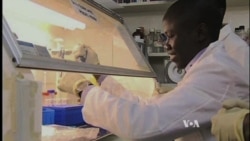Some of the brightest high school students in the United States showcased their ground-breaking math and science research at the annual Intel Science Talent Search.
Forty high school seniors, who came up with new technologies and scientific breakthroughs, competed for the top prizes of $150,000. Their innovations included a blood testing kit for smartphones, and a computer that identifies potential new drugs to combat disease.
Diseases like cancer, tuberculosis and Ebola kill millions of people each year. By combining computer technology with biochemistry, 17-year-old Anvita Gupta identified new medicines to combat these illnesses. She used an innovative technique to get a computer to look for potential drugs, earning a third place award at the competition, and $35,000.
“I actually found four new tuberculosis drugs. They’re natural compounds that have been screened from the ocean, isolated from the ocean near China,” said Gupta.
The search to cure skin cancer began as a personal quest for Emily Ashkin, after her mother was diagnosed with the disease. She took a novel approach to enhancing a treatment that uses the body’s own immune system T-cells to help fight melanoma, the deadliest form of skin cancer.
“I discovered how to make the cancer cells more recognizable to the killer T-cells by using chemotherapy treatment, by using drugs to manipulate the cancer cells, slow them down, and make them more vulnerable and susceptible to the killer cells to be able to recognize them,” said Ashkin.
Early malaria detection can save many lives. A smartphone that detects the parasites that cause malaria and other blood diseases may be the wave of the future, especially in developing countries.
Tanay Tandon created a low-cost microscope lens that attaches to a smartphone camera. Photos of patient blood samples give rural doctors a tool to quickly identify parasites.
“The thing that I was targeting this towards is in rural areas," say Tandon. "There’s devastating parasite mortality rates because a lot of times these diseases go undetected.”
Cutting edge technology is helping these high school students make real scientific advances, according to Wendy Hawkins, Executive Director of the Intel Foundation, sponsor of the competition.
“Most of these students are doing work that’s certainly sophisticated enough that it would be at the senior levels of university level research," she said.
And that includes the work of Dhaivat Pandya, who thinks he’s found a way to increase the available bandwidth on large computer networks, including the Internet, which continues to grow worldwide.
“We have to find a way to use our existing infrastructure to support all these new users and all this new data. So we have to be able to solve the problem of increasing the bandwidth to maintain the speeds that are available on the Internet today,” said Pandya.
This year’s competitors join other alumni who have gone on to make extraordinary contributions to math and science -- and received even greater awards -- including the Nobel Prize.











